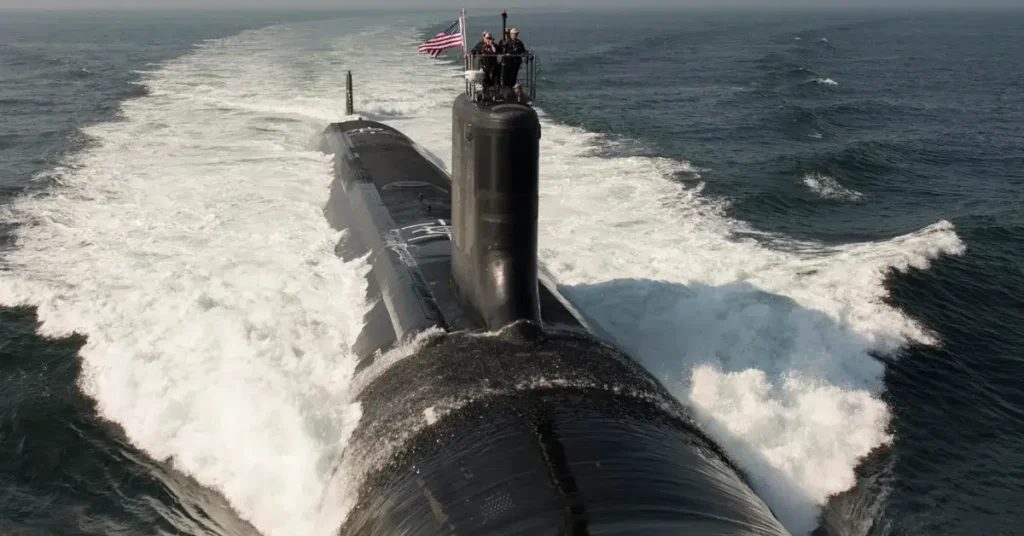
Plunge into the hidden Interior Submarine design world, where every square inch is meticulously crafted for life beneath the waves. Discover how these underwater marvels, exemplified by the USS South Dakota, merge advanced technology with compact living to become the epitome of modern marine engineering.
In this concise guide, we’ll explore how submarines sustain life and ensure operational efficiency in the ocean’s depths, providing a home for crews like those on the USS Florida amidst the high-pressure aquatic expanse. Join us as we unveil the secrets of submarine interiors, where innovation meets necessity in the most extraordinary living spaces.
As passionate marine enthusiasts, We are thrilled to guide you through the stylish world of Interior Submarine Designs, where functionality meets elegance beneath the waves.
Submarine Design and Layout
When we think about an interior submarine design, it’s like entering into a new dimension where space is optimized, and every inch serves a purpose. From the robustness of the structure to the living quarters and the buzzing control room, each element is a testament to human engineering. Let’s dive in and discover what makes these vessels functional and habitable.
Structural Engineering
The submarine’s resilience lies within its structural engineering. The pressure hull is a masterpiece of strength, designed to withstand the intense pressure of the deep sea. It’s fascinating how using materials and strategic design provides safety and maintains the platform’s integrity throughout its operational depth.
Crew Quarters and Amenities
Crew quarters and amenities are second to none in keeping the crew’s morale high. The galley serves as a kitchen, providing healthy and tasty meals, which is quite a feat. To stay fit, there are often onboard gyms—though small— they are packed with equipment catered to a variety of workouts.
Control Room Dynamics
The heartbeat of submarines, the control room, is a hub of activity. It is here where you can sense the pulse of the submarine, with constant monitoring of various systems, including the oxygen levels crucial for our survival underwater. The dynamic nature of running a submerged vessel relies on this epicenter, where precision and attention to detail are the order of the day.
Operational Systems

Submarines are equipped with advanced technologies and systems to navigate the ocean’s depths, communicate with the outside world, and keep the crew alive and well.
Communication Technologies
Radios and Antennas: Submarines boast state-of-the-art communication equipment. They use a range of systems to maintain contact with commands. These include VLF (Very Low Frequency) radios that can reach the crew even when submerged at deep levels in the ocean. Satellite communications are also available.
- Periscope: At periscope depth, crews leverage the periscope for visual aid and higher bandwidth communications, sending and receiving signals via encrypted channels.
Navigation and Propulsion
Sonar and Navigation Tools: The navigation suite is a work of art. High-resolution sonar is used to detect obstacles and navigational hazards in the ocean’s murky depths. The latest inertial navigation systems keep the crew on course without surfacing for GPS updates.
Oxygen and Life Support
Oxygen Generation and Filtration:
- CO2 Scrubbers: Sophisticated carbon dioxide scrubbers are used to remove exhaled CO2 from our environment.
- Electrolysis: Water is split into oxygen and hydrogen through electrolysis, replenishing the oxygen supply.
These operational systems synergize to make the interior submarine a bastion of advanced technology and a comfortable and safe environment for the crew to live and work in while exploring the vastness and mysteries of the ocean.
Historical Significance

As we delve into the depths of submarine history, we uncover the remarkable progression of interior submarine design and its pivotal role in shaping naval warfare.
World Wars Impact
During World War I, the German U-boat emerged as a formidable underwater vessel, marking a significant shift in naval tactics. These submarines had comparatively primitive interiors by today’s standards, but their ability to silently stalk and strike gave them a fearsome reputation. In the confined quarters of U-boats, the daring crews braved the oceans to disrupt Allied supply lines, influencing the war’s outcome.
World War II further underscored the strategic importance of submarines as the U.S. Navy expanded its fleet, introducing more sophisticated interiors catering to the demands of extended underwater operations. The USS Holland, the first submarine commissioned by the U.S. Navy, paved the way for these advancements.
Modern Naval Evolution
The postwar period saw the rise of the nuclear-powered submarine, a leap in technological sophistication that revolutionized interior submarine design. The introduction of nuclear power meant that submarines could now operate underwater for months without surfacing, necessitating more sustainable interior environments for the crew. This innovation significantly extended the naval base of operations, allowing submarines to become an integral part of a nation’s strategic deterrent force.
The sleek, modern interiors of today’s submarines reflect decades of iteration and improvement, serving as mobile command centers equipped with advanced navigation and communication systems. The influence of these designs is felt throughout the nautical world as nations understand power beneath the waves, which translates to a commanding presence on the global stage.
Exploration and Research

Exploring the ocean’s depths aboard an interior submarine reveals the unseen wonders beneath the waves. We witness incredible marine ecosystems, historic shipwrecks, and geological formations miles beneath the surface.
Deep-Sea Expeditions
The allure of the deep sea is irresistible. With sophisticated submersible vessels like the ones used by NOAA’s Office of Ocean Exploration and Research, we can embark on expeditions that were once unimaginable. We explore hydrothermal vents, deep-sea trenches, and underwater mountains. For instance, OceanGate offers expeditions to visit the Titanic wreck, bringing us face-to-face with a slice of maritime history resting on the seafloor.
- Objective: Understand deep-sea environments and biology.
- Critical Missions: Study of the Titanic wreck, ecological surveys.
- Capabilities: Extended dive times, advanced imaging systems.
| Feature | Details |
| Personnel Sphere | Ergonomic interior, improved visibility |
| Power Systems | Enable longer dive times |
| Sensors and Imaging | High-definition, improved data acquisition |
Maritime Archaeology
Maritime archaeology within an interior submarine involves sophisticated technology to unravel the stories hidden on the ocean floor. From ancient trade ships to warship wreckage, we record, preserve, and analyze the remains of human endeavor. By visiting sites like the Titanic’s resting place, we pay homage to historical events and gather invaluable data about shipbuilding evolution and the factors contributing to maritime disasters.
- Focus: Preservation and study of underwater cultural heritage.
- Techniques: 3D modeling, non-invasive site analysis.
By employing advanced technologies housed within our submersibles, we ensure that even the most hard-to-reach wreckage is documented and studied, contributing to our understanding of the past.
Our Opinion on the USS South Dakota Interior Design

Delving into the Interior Submarine design, we’re in awe of the USS South Dakota’s fusion of technology and compact living. We believe these spaces showcase the pinnacle of ingenuity in marine engineering, offering a sustainable and efficient home for crews in the vast underwater realm.
Our opinion on the USS South Dakota interior design is of deep admiration. The Interior Submarine space is a testament to human ingenuity, balancing advanced technological needs with the demands of compact maritime living.
We’re captivated by how the USS South Dakota’s interior exemplifies this blend, offering a glimpse into the sophisticated world of submarine design that supports life under immense oceanic pressure.
FAQ – Interior Submarine

Exploring the interior of a submarine is a fascinating adventure into the world beneath the waves. Let’s dive into some common questions about what it’s like inside these incredible underwater vessels.
Can you see from inside a submarine?
Sightseeing: Inside a submarine, our central view of the outside is through periscopes. Traditional submarines use lenses and prisms in a long tube to provide a line of sight above the water’s surface. Newer models may utilize electronic periscopes called photonics masts, which relay digital images to screens inside the vessel.
What is the inside of a submarine called?
Compartmentalization: The interior is divided into various compartments. For instance, there’s the control room, also called the conn, where we steer the sub and manage its operations. Living quarters, machinery spaces, and the torpedo room are other distinctive sections, each known by their specific function.
Can you go inside a submarine?
Access Galore: Absolutely, we can. Many decommissioned submarines are open to the public for tours. Operational submarines, however, have strict access protocols for apparent safety and security reasons, allowing entry only to authorized personnel.
Is it cold inside submarines?
Climate Control: It might be chilly outside in the depths, but inside, our submarines are climate-controlled for comfort. The temperature is manually regulated and maintained to ensure the well-being of everyone on board. It’s cozy, ensuring we can focus on our tasks despite the cold ocean.
Do you Have thoughts on the Interior Submarine design trends? Dive into the discussion below and share your insights with fellow sea-tech enthusiasts!

